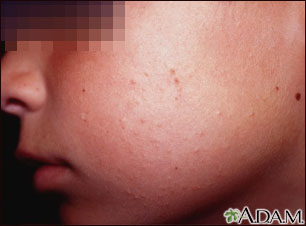Dry Winter Air Means Itchy Flaky Cranky Kids- Here's What You Can Do!
It's that time of year- the heat is on indoors, and the humidity in our homes takes a nosedive. Kids (especially those with a history of eczema) start getting itchy, scaly, cracked skin. Ouch! We all want to minimize the amount of medication we apply to our children's bodies, so try these these quick tips first:
1. lukewarm baths/showers, no greater than 10 minutes
2. pat (don't rub) dry with a towel that is free of fabric softener
3. immediately apply an emollient - a ceramide-containing cream all over the body in the AM (Cera/ve, Mimyx, Atopiclair are all good choices), and don't skimp on the petroleum jelly at bedtime (who cares of they're a little slippery?)
4. keep the ambient humidity in your home between 40-50%
5. turn down the heat!
For most cases of dry winter skin, the above is enough to keep a bad eczema flare at bay. However, if your child's skin does flare up, don't be afraid to use the topical anti-inflammatory ointments (they work better than creams or lotions) aggressively for a short period of time. As the condition of the skin improves, you'll be able to back off on the frequency of application.
Below is the text of the dry skin care regimen I suggest for my patients:
Cleansing:
Bathe/shower with warm water (never hot!) for no longer than 10 minutes 1-2 times daily. Apply soap to the following areas only: folds of neck, underarms, groin, buttocks, palms, and soles.
The following cleansers are mild enough for daily use:
Moisturizing:
After bathing, pat (don’t rub) with a towel until the skin is mostly dry. Apply generous amount of moisturizer/emollient to skin immediately after drying, and rub until no longer visible. Avoid most lotions, which contain mostly water, and are not effective at locking moisture into the skin. The simplest and least expensive emollient is simply petroleum jelly. Other effective OTC options include: Cera/ve cream, Vanicream, Eucerin cream, Aquaphor, and Aveeno Cream.
Topical Medications:
Once moisturizer/emollient is absorbed into skin, apply topical anti-inflammatory medication to affected areas only. See instructions below:
Acute flare of eczema: TBD by physician
Resolving eczema patches: TBD by physician
Maintenance for areas prone to flares: TBD by physician
Laundry:
Cotton clothing is best for sensitive skin. Use dye-free, fragrance-free detergent, such as ALL Free and Clear. Use hot water and a second rinse cycle to ensure that all detergent is washed out of your clothing. Avoid fabric softener, especially dryer sheets.
1. lukewarm baths/showers, no greater than 10 minutes
2. pat (don't rub) dry with a towel that is free of fabric softener
3. immediately apply an emollient - a ceramide-containing cream all over the body in the AM (Cera/ve, Mimyx, Atopiclair are all good choices), and don't skimp on the petroleum jelly at bedtime (who cares of they're a little slippery?)
4. keep the ambient humidity in your home between 40-50%
5. turn down the heat!
For most cases of dry winter skin, the above is enough to keep a bad eczema flare at bay. However, if your child's skin does flare up, don't be afraid to use the topical anti-inflammatory ointments (they work better than creams or lotions) aggressively for a short period of time. As the condition of the skin improves, you'll be able to back off on the frequency of application.
Below is the text of the dry skin care regimen I suggest for my patients:
Dry Skin / Eczema Care Instructions
Cleansing:
Bathe/shower with warm water (never hot!) for no longer than 10 minutes 1-2 times daily. Apply soap to the following areas only: folds of neck, underarms, groin, buttocks, palms, and soles.
The following cleansers are mild enough for daily use:
- Aveeno Skin Relief Fragrance Free Body Wash
- Basis Sensitive Skin Bar
- Cetaphil Gentle Cleansing Bar
- Dove Sensitive Skin Beauty Body Wash
- Dove Sensitive Skin Unscented Beauty Bar
- Vanicream Cleansing Bar
Moisturizing:
After bathing, pat (don’t rub) with a towel until the skin is mostly dry. Apply generous amount of moisturizer/emollient to skin immediately after drying, and rub until no longer visible. Avoid most lotions, which contain mostly water, and are not effective at locking moisture into the skin. The simplest and least expensive emollient is simply petroleum jelly. Other effective OTC options include: Cera/ve cream, Vanicream, Eucerin cream, Aquaphor, and Aveeno Cream.
Topical Medications:
Once moisturizer/emollient is absorbed into skin, apply topical anti-inflammatory medication to affected areas only. See instructions below:
Acute flare of eczema: TBD by physician
Resolving eczema patches: TBD by physician
Maintenance for areas prone to flares: TBD by physician
Laundry:
Cotton clothing is best for sensitive skin. Use dye-free, fragrance-free detergent, such as ALL Free and Clear. Use hot water and a second rinse cycle to ensure that all detergent is washed out of your clothing. Avoid fabric softener, especially dryer sheets.



Thanks for another great article. interestingly enough, Johnson's and Johnson's baby bath/shampoo isn't on there althouth it's deemed as hypoallergenic. any thoughts on that? often get alot of questions on it bc also need a mild shampoo to avoid irritating the skin as hair is washed also. Thanks...
ReplyDeleteI haven't added J&J to the list because the majority of their products are fragranced, and fragrance can be a sensitizer in many people.
ReplyDeleteHowever, for most patients, it is fairly well-tolerated. I certainly wouldn't be opposed to using it.